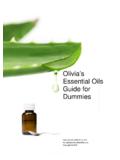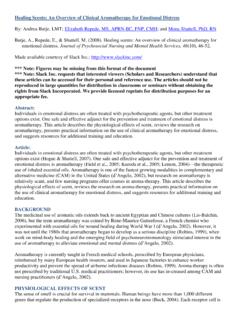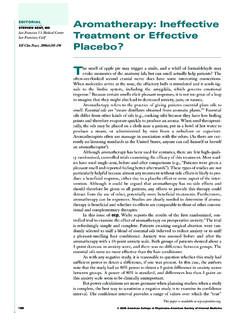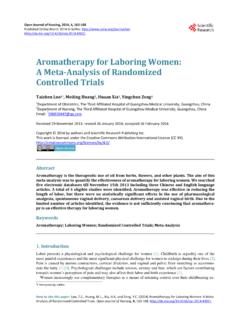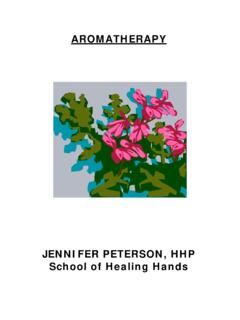Transcription of ESSENTIAL OILS FOR ANAGEMENT OF SYMPTOMS IN …
1 ESSENTIALOILS FORMANAGEMENT OFSYMPTOMSINCRITICALLYILLPATIENTSC linical Evidence Review160 AJCC AMERICAN JOURNAL OF CRITICAL CARE, March 2008, Volume 17, No. Margo A. Halm, RN, PhD, CNS-BC, CCRNWith therapeutic properties basedon their chemical composition, ESSENTIAL oils extracts fromherbs, flowers, and other plantmaterials have been used totreat SYMPTOMS and diseases for thousands of , the term aromatherapywas not used untilFrench chemist Gattefosse published a text in aromatherapy is defined as the use of essen-tial oils for therapeutic purposes that encompassmind, body, and is anewer technique in the United States, ESSENTIAL oilshave long been part of nursing practice in countrieslike the United Kingdom, Switzerland, Germany,Canada, and Australia.
2 ESSENTIAL oils are administered via inhalation(whereby oils travel directly through the olfactory bulbto the limbic system, where aromas are processed) ortopically with or without massage enhancement (withrapid absorption through the skin into the blood-stream within 10-30 minutes).3-5 When ESSENTIAL oilsare used, their purpose should be made explicit withtherapeutically targeted outcomes that are measurableby objective and subjective ,4,5 This clinical review summarizes current evidencerelated to the following question: How effective areessential oils in management of SYMPTOMS in criti-cally ill patients?MethodsThe search strategy included MEDLINE, CINAHL,and COCHRANE databases, along with handsearching the bibliographies of retrieved words included ESSENTIAL oils , aromatherapy ,massage, symptom management, anxiety/stress, insom-nia/sleep, pain,and intensive care unit(ICU).
3 Alltypes of evidence (nonexperimental, experimental,systematic reviews, case reports) were included,but only evidence from studies that enrolled criti-cally ill patients was 1992 to 1998, five studies6-11were pub-lished, along with 1 systematic review,1one litera-ture review,12and one ICU case studieswere quantitative, and all but one of the studies11were conducted in the United Kingdom. Sample sizesranged from 25 to 122. Targeted SYMPTOMS includedanxiety,7-11stress,6-8,10mood/co ping,10disrupted sleep,6-8,11and effects of aromatherapy accompaniedby massages of the whole body (lavender oil)9,10orfoot (neroli oil)6-8were tested against massages withcarrier oils (sweet almond, grapeseed, apricot, spikelavender).
4 One study solely examined the effects oflavender duration and frequency included oneinhalation11or massage treatment,7,8two 20-minutemassages on consecutive days9or in 1 week,6or three15- to 30-minute massages 24 hours effecton SYMPTOMS was assessed by measuring vital signsand having patients complete self-report scales imme-diately before and after treatments,6-8,10as well as atintervals of 20 and 30 minutes,6thirty to 60 minutes,11and 1 and 2 hours7,8after treatment and upon awaken-ing the next on these intervals, short-termbenefits of the intervention were regular feature of the American Journal of Critical Care,Clinical Evidence Reviewunveils available scientific evidence to answer questions facedin contemporary clinical practice.
5 It is intended to support, refute, or shed light on healthcare practices where little evidence exists. To send aneLetter or to contribute to an online discussion about this article, visit click Respond to This Article on either thefull-text or PDF view of the article. We welcome letters regarding this feature and encourage the submission of questions for future review. by AACN on November 19, 2018 from Table 1 provides a summary of the evidence. In3 studies,6-8,10researchers found significantly reducedanxiety or stress; in 2 studies,6-8researchers foundimproved restfulness; and in 1 study,6researchersfound decreased pain. No effect on coping or moodwas 2 large randomized controlled tri-als7,8,10represent class IIb evidence (Table 2) for posi-tive immediate effects of a 15- to 30-minutearoma therapy massage on anxiety and stress, withno evidence of harm.
6 However, in the study byDunn et al,10anxiety was reduced only in the first of3 sessions. Furthermore, although Stevenson7,8reported more anxiety reduction in the massagegroups than in the control groups, no difference inanxiety was observed between the group that receivedthe aromatherapy foot massage and the group thatreceived foot massage without aromatherapy . Fromthese findings, it is not clear whether the positiveeffects on anxiety were from the therapeutic actionof the ESSENTIAL oil or from the plain Based on Current EvidenceDespite preliminary evidence, Cooke and Ernst1caution that the mechanism of action of essentialoils is unclear. Even though the oils were appliedtopically, did smell or psychological associationplay any role in their effect?
7 Furthermore, essentialoils are often practiced with massage, confoundingresults and making it difficult to determine the spe-cific source of the treatment ,14 Some argue that the effects of aromatherapy mas-sage are only transient, without sustained JOURNAL OF CRITICAL CARE, March 2008, Volume 17, No. 2161 About the AuthorMargo A. Halm is a clinical nurse specialist and director ofnursing research and quality at United Hospital in St. Paul,Minnesota, where she leads and mentors staff in principlesof clinical research and evidence-based author:Margo A. Halm, RN, PhD, CNS-BC,CCRN,United Hospital - Mailstop 60231, 333 N. Smith Ave,St. Paul, MN 55102 (e-mail: 1 Studies of ESSENTIAL oils and symptom managementWoolfson and Hewitt6 Buckle9 Stevenson7,8 Dunn et al10 Borromeo11 Cooke and Ernst136 General ICU28 Cardiac sur-gery ICU100 Cardiac sur-gery ICU122 General ICU25 Coronary care488 (3 ICUstudies)ComparativeFoot massage (lavender), foot massage (almond), vs control Two 20-minute sessions per weekComparativeMassage (English lavender) vs massage (spike lavender) Two 20-minute sessions on consecutive days Randomized controlled trialFoot massage (neroli), foot massage(apricot), vs control One 20-minute session Randomized controlled trialAromatherapy massage (1% lavender),massage (grapeseed))
8 Vs control Three 15- to 30-minute sessions in 5 days Randomized controlled trial aromatherapy inhalation (9-hour passive diffusion of lavender) vs controlSystematic review HeterogeneousIIbIIIIIbIIbIIII ndeterminateStudy Design/intervention N and locationResultsaLevel of evidence, classAbbreviation: ICU, intensive care : +, improved SYMPTOMS ; 0, no difference in SYMPTOMS .+ Physiological stress (heart rate/systolic blood pressure/respiratory rate) + Wakefulness+ Pain0 Anxiety+ Anxiety + Physiological stress (respiratory rate)+ Subjective perceptions (relaxing, restful)0 Physiological stress (heart rate/blood pressure)+ Anxiety0 Mood/coping0 Physiological stress (heart rate, systolic and diastolic blood pressure)0 Anxiety0 Sleep quality+ Anxiety by AACN on November 19, 2018 from Undeniably, Stevenson7,8found an immediate reduc-tion in respiratory rate with no sustained effect at 2hours.
9 Another central question is whether individ-ual sessions are as effective as multiple ones, or if acumulative effect exists. The answer to this questionmay vary by ESSENTIAL oil or targeted symptom com-plex. Experts also suggest that the choice of an aromais very important when psychological effects such asanxiety reduction are informationcould prove challenging to obtain from the mostcritically ill patients (who may benefit the most).Although the best choice of oil, application, andduration of effect undoubtedly warrants furtherstudy, why is the transient effect of integrative thera-pies such as aromatherapy (whose intent is to reducephysical or psychological SYMPTOMS ) any differentthan the need to redose analgesics or other medica-tions regularly for symptom control?
10 Finally, aro-matherapy massage has been challenging to supportwith research because integrative therapies placemore emphasis on subjective validation of effective-ness than on the typical Western research model thatadvocates objective and other questions about administration,safety, control of the quality of ESSENTIAL oils , inter-actions with other therapies/modalities, and effec-tiveness measures must be addressed before thetherapeutic use of ESSENTIAL oils takes hold in main-stream critical care nursing practice. 162 AJCC AMERICAN JOURNAL OF CRITICAL CARE, March 2008, Volume 17, No. into the therapeutic effects of essentialoils is in its infancy, so this intervention is ripe forfurther scientific investigation.


